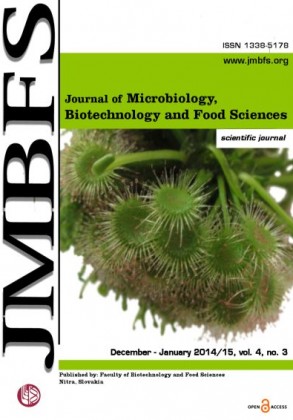EVALUATION OF REPRODUCTIVE PERFORMENCE OF DOVES AFTER TREATMENT WITH INSEMINATION DOSE IMPLEMENTER HEPARIN
DOI:
https://doi.org/10.15414/jmbfs.2014-15.4.3.217-219Keywords:
Heparin, rabbit, reproduction, interaction sperm - folliculesAbstract
The aim of the study was to evaluate the effect of implementer heparin on the interaction follicles - sperm, conceptual ratio and the number of pups born in inseminated doves inseminated The experimental group was inseminated with 0.5 ml insemination dose inseminated 15 min. incubation with heparin (25 000 IU / l ml) of concentrations of 0.06 ml / 0.5 ml / ID (0.06 ml = 10 mg). The control group was inseminated with 0.5 ml insemination dose without implementer. The addition of heparin implementer has led to an increase in the reproductive performance in vitro and in vivo. Number of zygotes with two pronucleus represented in the control group 74.5% of the total number of follicles stranded in the group. In the experimental group, the number of zygotes with two pronucleus accounted for 81.08% of the total number of follicles stranded in the group. In vivo, we found a conceptual ratio 89.28% with an average number of live pups per litter 10.64 ± 3.41 pc in experimental doves. In the control group the conceptual ratio was 72.00% with an average number of pups per litter 8.55 ± 3.22 pc. The conceptual relation between the control K and experimental GAG group of doves has show a statistically significant difference (χ24, 15 +). In the number of live born pups between control K and experimental GAG group a statistically significant difference (2.02 + T41) was observed too.Downloads
Download data is not yet available.
Downloads
Published
2014-12-01
How to Cite
Fik, M., Parkányi, V., OndruÅ¡ka, ĽubomÃÂr, & MalÃková, L. (2014). EVALUATION OF REPRODUCTIVE PERFORMENCE OF DOVES AFTER TREATMENT WITH INSEMINATION DOSE IMPLEMENTER HEPARIN. Journal of Microbiology, Biotechnology and Food Sciences, 4(3), 217–219. https://doi.org/10.15414/jmbfs.2014-15.4.3.217-219
Issue
Section
Biotechnology
License
Copyright (c) 2014 Martin Fik, VladimÃÂr Parkányi, ĽubomÃÂr OndruÅ¡ka, Lenka MalÃková

This work is licensed under a Creative Commons Attribution 4.0 International License.
All papers published in the Journal of Microbiology, Biotechnology and Food Sciences are published under a CC-BY licence (CC-BY 4.0). Published materials can be shared (copy and redistribute the material in any medium or format) and adapted (remix, transform, and build upon the material for any purpose, even commercially) with specifying the author(s).





